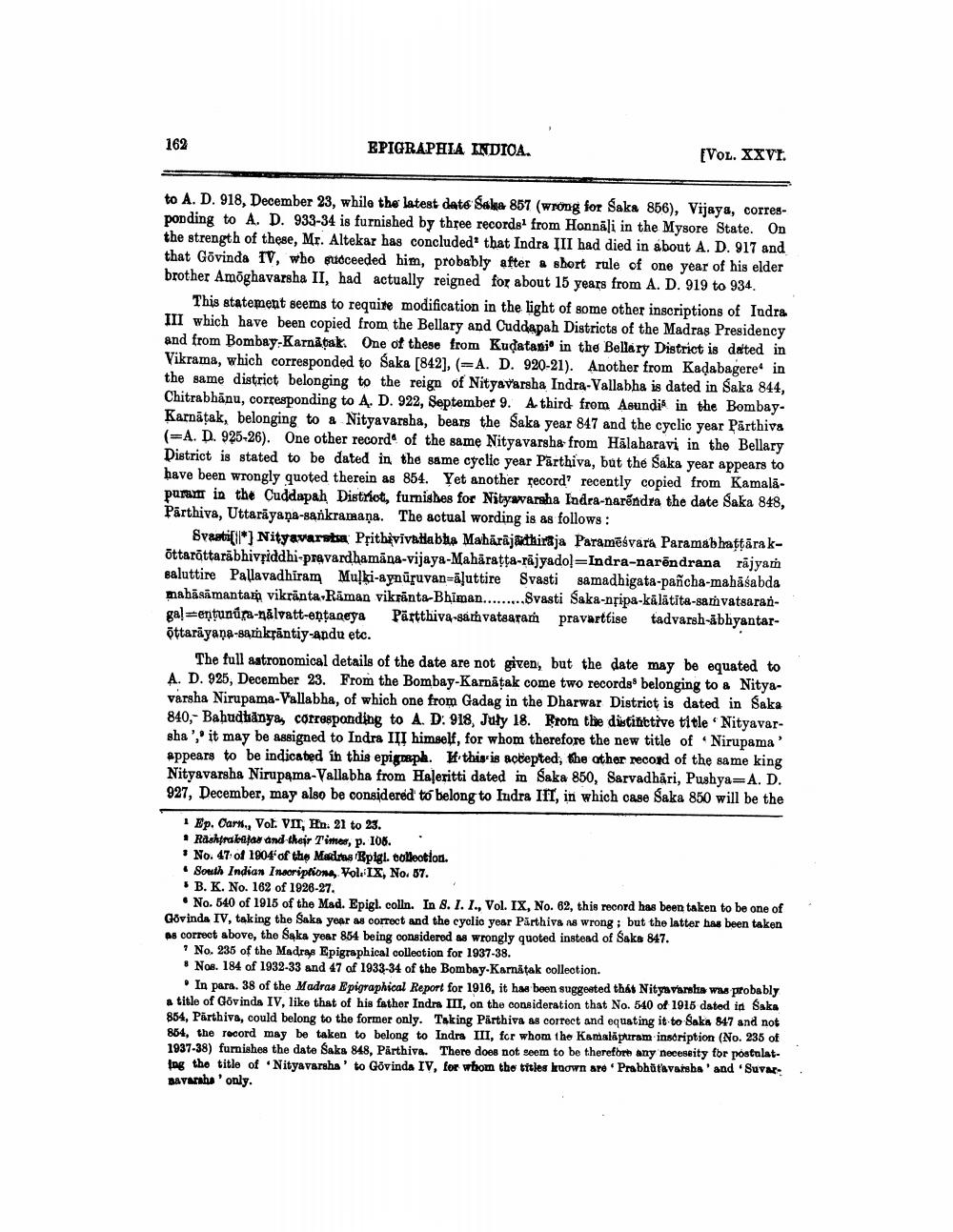________________
162
EPIGRAPHIA INDICA.
to A. D. 918, December 23, while the latest date Saka 857 (wrong for Saka 856), Vijaya, corresponding to A. D. 933-34 is furnished by three records1 from Honnali in the Mysore State. On the strength of these, Mr. Altekar has concluded that Indra III had died in about A. D. 917 and that Govinda IV, who succeeded him, probably after a short rule of one year of his elder brother Amoghavarsha II, had actually reigned for about 15 years from A. D. 919 to 934.
This statement seems to require modification in the light of some other inscriptions of Indra III which have been copied from the Bellary and Cuddapah Districts of the Madras Presidency and from Bombay-Karnatak. One of these from Kuḍatani" in the Bellary District is dated in Vikrama, which corresponded to Saka [842], (=A. D. 920-21). Another from Kadabagere in the same district belonging to the reign of Nityavarsha Indra-Vallabha is dated in Saka 844, Chitrabhānu, corresponding to A. D. 922, September 9. A third from Asundi in the BombayKarnatak, belonging to a Nityavarsha, bears the Saka year 847 and the cyclic year Parthiva (=A. D. 925-26). One other record of the same Nityavarsha from Halaharavi in the Bellary District is stated to be dated in the same cyclic year Parthiva, but the Saka year appears to have been wrongly quoted therein as 854. Yet another record recently copied from Kamalapuram in the Cuddapah District, furnishes for Nityavarsha Indra-narendra the date Saka 848, Parthiva, Uttarayana-sankramana. The actual wording is as follows:
Svasti[*] Nityavarsha Prithivivallabha Mahārājathiraja Paramesvara Paramabhaṭṭāraköttarōttarābhivriddhi-pravardhamana-vijaya-Mahāraṭṭa-rajyadol-Indra-narendrana rajyam saluttire Pallavadhiram Mulki-aynuruvan-aluttire Svasti samadhigata-pañcha-mahāśabda mahāsāmantaṁ vikranta-Raman vikranta-Bhiman.........Svasti Saka-nripa-kälätita-samvatsaranPärtthiva-samvatsaram pravarttise tadvarsh-äbhyantar
gal=entunúra-nālvatt-enṭaneya öttarayana-samkrāntiy-andu etc.
[VOL. XXVI.
The full astronomical details of the date are not given, but the date may be equated to A. D. 925, December 23. From the Bombay-Karnaṭak come two records belonging to a Nityavarsha Nirupama-Vallabha, of which one from Gadag in the Dharwar District is dated in Saka 840,- Bahudhanya, corresponding to A. D: 918, July 18. From the distinctive title Nityavarsha', it may be assigned to Indra III himself, for whom therefore the new title of Nirupama' appears to be indicated in this epigraph. If this is accepted, the other record of the same king Nityavarsha Nirupama-Vallabha from Haleritti dated in Saka 850, Sarvadhari, Pushya-A. D. 927, December, may also be considered to belong to Indra III, in which case Saka 850 will be the
1 Ep. Carn,, Vol. VII, Hn. 21 to 23.
• Rashtrabajar and their Times, p. 108.
No. 47 of 1904 of the Madras Epigl. collection.
South Indian Inscriptions, Vol. IX, No. 57.
B. K. No. 162 of 1926-27.
No. 540 of 1915 of the Mad. Epigl. colln. In 8. I. I., Vol. IX, No. 62, this record has been taken to be one of Govinda IV, taking the Saka year as correct and the cyclic year Parthiva as wrong; but the latter has been taken as correct above, the Saka year 854 being considered as wrongly quoted instead of Saka 847.
No. 235 of the Madras Epigraphical collection for 1937-38.
Nos. 184 of 1932-33 and 47 of 1933-34 of the Bombay-Karnatak collection.
In para. 38 of the Madras Epigraphical Report for 1916, it has been suggested that Nityavarsha was probably a title of Govinda IV, like that of his father Indra III, on the consideration that No. 540 of 1915 dated in Saka 854, Parthiva, could belong to the former only. Taking Pärthiva as correct and equating it to Saka 847 and not 854, the record may be taken to belong to Indra III, for whom the Kamalapuram inscription (No. 235 of 1937-38) furnishes the date Saka 848, Parthiva. There does not seem to be therefore any necessity for postulatIng the title of Nityavarsha' to Govinda IV, for whom the titles known are ' Prabhutavarsha' and 'Suvar Bavaraha' only.




